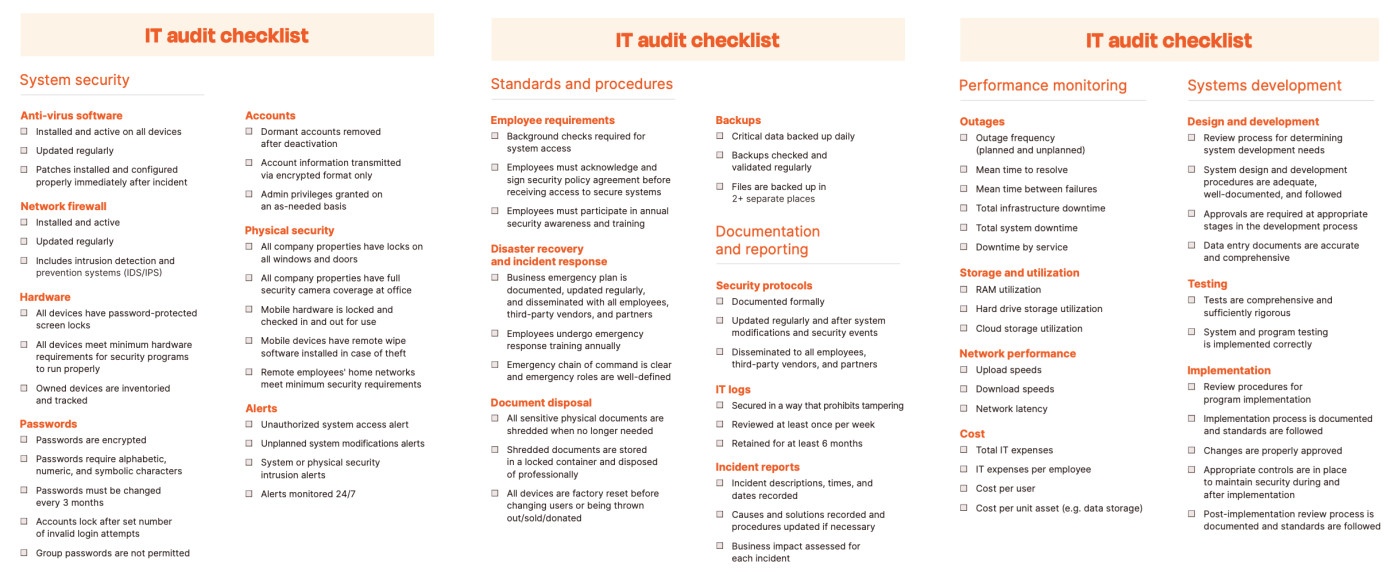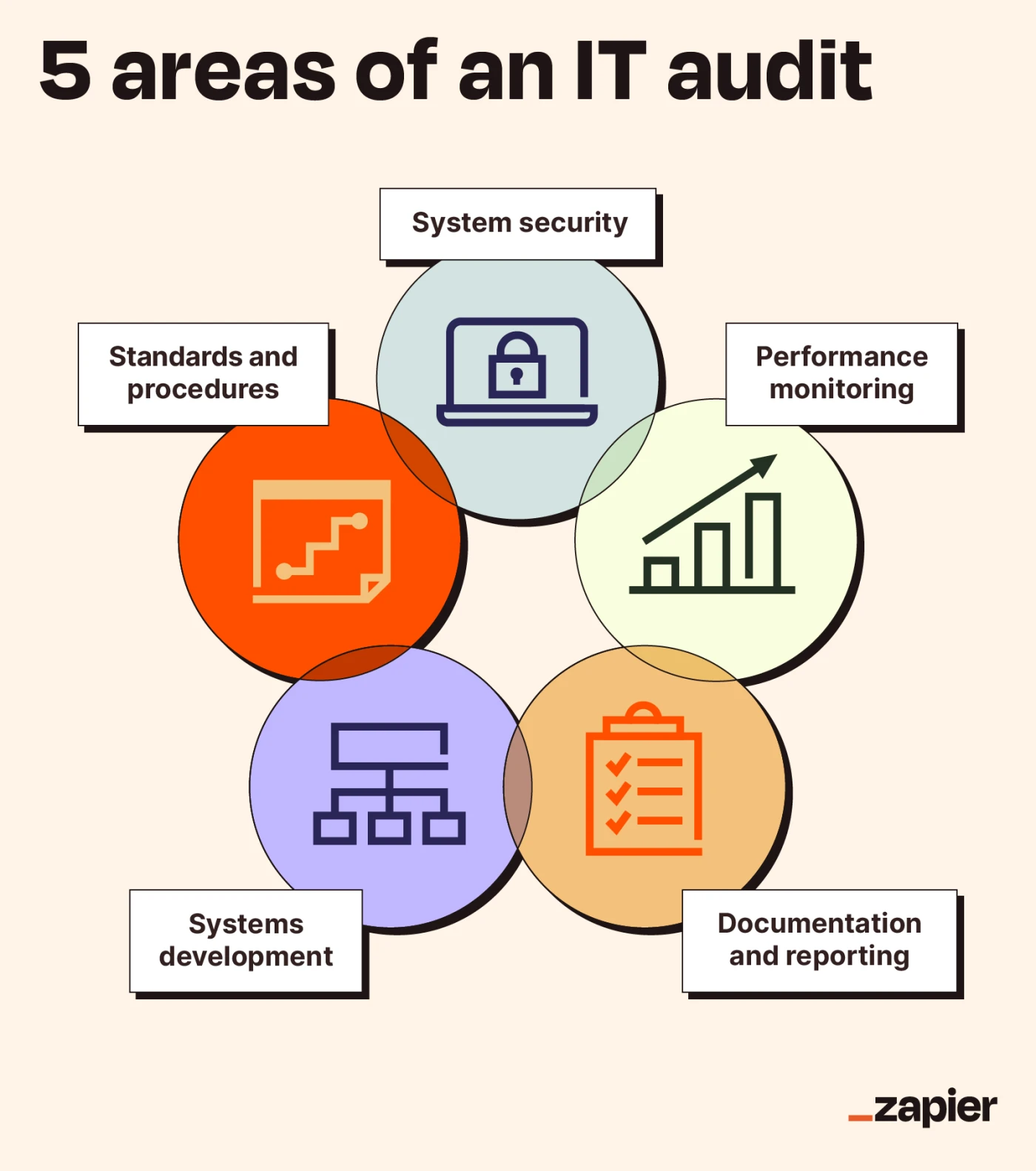

Americans' abysmal cyber-hygiene is bad news for individuals at risk of attack, but the stakes are far higher for the companies that employ them. Especially when employees work from home or bring tech with them on work trips, they're likely to expose the company's entire infrastructure to a potential risk.
What's the answer? Business owners need to conduct regular IT audits to make sure that their systems are uncompromised and their employees are up-to-date on their cybersecurity know-how. These audits also provide a way to be sure costs, speeds, and protocols are on point. If it's your first time tackling an IT audit, our checklist will guide you through the basics.
Table of contents:
An IT audit is an evaluation of an organization's information technology infrastructure (including devices), policies, and procedures. It's designed to ensure that IT systems are functioning properly and securely and that employees are abiding by security standards by using them safely and correctly.
Automate your IT management workflowsDepending on how large your organization is, you can either run a single comprehensive IT audit or audit different areas of your infrastructure individually. And depending on what your IT processes look like, there are a few different types of IT audits you can consider to shore up security. Here are some examples:
Across the board, the goal is to assess the risks associated with your IT systems and to find ways to mitigate those risks, either by solving existing problems, correcting employee behavior, or implementing new systems.
In short: because everything your business does depends on a functioning IT ecosystem. Technology, like Bob Dylan once said, is a-changin', and so are cyber threats. Regular IT audits ensure your IT operations are keeping up with evolving standards in software and hardware while staying vigilant in the face of smarter and smarter cyber attackers.
More specifically, IT audits help businesses:

If you're already ready to execute your next IT audit—congrats, no need to read the rest of this post.
You'll also do well to keep these complex processes and detailed procedures organized with a dedicated doc. The IT checklist above divides common audit tasks into five typical IT buckets we'll explore in the next section in more detail: system security, standards and procedures, documentation and reporting, performance monitoring, and systems development.
Keep in mind that a checklist, while essential, isn't sufficient internal documentation for an audit. The point of running this evaluation is to get a detailed understanding of your infrastructure's weaknesses and tailored, actionable steps you can take to remedy them. In order to do that, you'll need a more sophisticated system than paper and a clipboard.
Usually, IT audits are conducted by an organization's IT manager or cybersecurity director (in smaller organizations, those roles may be occupied by the business owner or head of operations). There are five key areas of an IT audit that more or less correspond with an IT manager's key responsibilities:
Within each of these areas, the auditor will run through a checklist of items to evaluate. Our audit checklist covers all of the steps of a basic IT audit, but depending on your infrastructure needs, you may find that you need to add areas or that some of those listed aren't necessary for your company.

Though the IT audit itself usually happens over the course of a few days, the process really begins long before that, when you take a look at your calendar and start laying out plans to schedule an audit in the future.
The first decision you'll need to make is whether to conduct an internal audit or hire an outside auditor to come in and offer a third-party perspective on your IT systems. External audits are more common in large corporations or companies that handle sensitive data. For the majority of companies, an internal audit is more than adequate and will be a lot less expensive to plan. If you want a little extra peace of mind, you might establish a yearly internal audit and hire an outside auditor once every few years.
When planning your audit, you'll need to decide:
An auditor will likely need to speak with different employees and team managers to learn about your company's IT workflows, so it's important to make sure you're not booking your audit for a time when your employees are swamped with other work.
Once you have a general time frame hammered out, you'll need to work with your audit team to prepare for the audit itself. A shortlist of things you'll need to figure out in this stage includes:
And if you really want to make sure you've dotted your I's and crossed your T's, you can use our aforementioned checklist to keep your IT audit processes organized while you plan them out.
Yup, conducting the audit is only step three in the five-step audit process. This step is pretty self-explanatory—if you did step two correctly, then step three will just be to execute the plan you created.
Keep in mind that even the best laid plans of mice and men (or I guess in this case, mice and keyboards) do often go awry, so this step may also include finding a way around any last-minute obstacles. Make sure you build in plenty of time so that you're not in a rush—if you wind up missing things in the audit, that defeats its whole purpose.
After your audit is finished, you should have a hefty file of documentation to show for it with your auditor's notes, findings, and suggestions. The next step is to synthesize this information into an official audit report. This is the document you'll put on file for future reference and to help plan next year's audit.
Then, you'll want to create individual reports for the heads of each audited department. Summarize what was evaluated, run down the items that don't need changes, and highlight anything the department is doing really well. Then, give a rundown of the vulnerabilities the auditor identified, and separate them according to their cause:
Along with each item, explain what the next steps will be in order to address the identified risks. In situations where risks were caused by willful carelessness, you may also want to loop in your HR department for guidance on how to handle the issue.
Let's be realistic: many (if not most) infrastructure vulnerabilities are caused at least in part by human error. Human error is just as likely to interfere with the solutions your team implements to correct the risks identified by the audit.
After you deliver your report findings, put a date on the calendar to follow up with each team and ensure that corrections were implemented successfully. It's wise to schedule a few follow-ups throughout the year to check in with each team and make sure that everything continues to run smoothly until your next audit.
If you decide to handle your IT audits internally, it's a good idea to designate an auditor ahead of time and have them take relevant IT auditing courses to gain IT audit certification. Here are a few popular certifications to consider:
IT audit certifications aren't necessary, but they have a few pretty convincing advantages, like validating the security of your IT infrastructure, ensuring your teams are abiding by auditing fundamentals, and improving overall audit effectiveness. Let's just say it sounds a lot better when you can say your tech is backed by regular certified audits than it is to say your tech has occasional audits by an unnamed IT guy.
Keep in mind that certification takes time, so be prepared for your future auditor to set aside time to study up for their exam and pass it. Plus, there are other possible requirements, like mandatory work experience, application processing times, and the potential need to retake the exam.
The auditor will also need to maintain their certification, so once they're certified, it can be helpful to work checkpoints into their ongoing responsibilities to ensure they're keeping up with requirements.
As your company begins to move forward with its new solutions in place, set up dashboards for automatic KPI tracking and reporting, so you can measure the impact of each change. When you check in with your team in the months following your audit, pull these reports so that you can assess performance and troubleshoot anything that's not working the way you expected it to.
You can also set up automations to do these "check-ins" for you by running regular vulnerability scans and monitoring system performance. Instead of filling your calendar with individual check-in meetings, you can let your tech handle the heavy lifting and only get involved when you get an alert.
As you get more comfortable with the process and begin following up, here's a guide for how to automate your IT management.
Related reading:
This article was originally published in August 2022 by Amanda Pell. The most recent update was in August 2024.